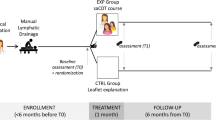Abstract
Background
Treatment of lymphedema is based on intensive decongestive physiotherapy followed by a long-term maintenance treatment. We analyzed the factors influencing lymphedema volume during maintenance treatment.
Method
Prospective cohort of 537 patients with secondary arm lymphedema were recruited in a single lymphology unit and followed for 12 months. Lymphedema volume was recorded prior to and at the end of intensive treatment, and at month 6 and month 12 follow-up visits. Multivariate models were fitted to analyze the respective role of the three components of complete decongestive therapy, i.e. manual lymph drainage, low stretch bandage, and elastic sleeve, on lymphedema volume during the 1-year maintenance phase therapy.
Results
Mean volume of lymphedema was 1,054 ± 633 ml prior and 647 ± 351 ml after intensive decongestive physiotherapy. During the 1-year maintenance phase therapy, the mean lymphedema volume slightly increased (84 ml—95% confidence interval [CI]: 56–113). Fifty-two percent of patients had their lymphedema volume increased above 10% from their value at the end of the intensive decongestive physiotherapy treatment phase. Non-compliance to low stretch bandage and elastic sleeve were risk factors for an increased lymphedema after 1-year of maintenance treatment (RR: 1.55 [95% CI: 1.3–1.76]; P < 0.0001 and RR: 1.61 (95% CI: 1.25–1.82); P = 0.002, respectively). Non-compliance to MLD was not a risk factor (RR: 0.99 [95% CI: 0.77–1.2]; P = 0.91).
Conclusion
During maintenance phase after intensive decongestive physiotherapy, compliance to the use of elastic sleeve and low stretch bandage should be required to stabilize lymphedema volume.
Similar content being viewed by others
References
Meric F, Buchholz TA, Mirza NQ et al (2002) Long-term complications associated with breast-conservation surgery and radiotherapy. Ann Surg Oncol 9:543–549
Ozaslan C, Kuru B (2004) Lymphedema after treatment of breast cance. Am J Surg 187:69–72
Clark B, Sitzia J, Harlow W (2005) Incidence and risk of arm oedema following treatment for breast cancer: a three-year follow-up study. Q J Med 98:343–348
Tobin M, Lacey HJ, Meyer L, Mortimer PS (1993) The psychological morbidity of breast cancer related arm swelling. Cancer 72:3248–3252
Földi E, Földi M, Clodius L (1989) The lymphedema chaos: a lancet. Ann Plast Surg 22:505–515
Ko DS, Lerner R, Klose G, Cosimi AB (1998) Effective treatment of lymphedema of the extremities. Arch Surg 133:452–458
Harris SR, Hugi MR, Olivotto IA, Levine M, Steering Committee for Clinical Practice Guidelines for the Care and Treatment of Breast Cancer (2001) Clinical practice guidelines for the care and treatment of breast cancer: 11. Lymphedema. CMAJ 164:191–199
International Society of Lymphology (2003) The diagnosis and treatment of peripheral lymphedema. Consensus document of the International Society of Lymphology. Lymphology 36:84–91
Lennihan R Jr, Mackereth M (1973) Calculating volume changes in a swollen extremity from surface measurements. Am J Surg 126:649–652
Sitzia J (1995) Volume measurement in lymphoedema treatment: examination of formulae. Eur J Cancer Care 4:11–16
Megens AM, Harris SR, Kim-Sing C, McKenzie DC (2001) Measurement of upper extremity volume in women after axillary dissection for breast cancer. Arch Phys Med Rehabil 82:1639–1644
Galland C, Auvert JF, Flahault A, Vayssairat M (2002) Why and how post-mastectomy edema should be quantified in patients with breast cancer. Breast Cancer Res Treat 75:87–89
Cohen SR, Payne DK, Tunkel RS (2001) Lymphedema. Strategies for management. Cancer 92:980–987
Casley-Smith JR, Casley-Smith JR (1992) Modern treatment of lymphoedema I. Complex physical therapy: the first 200 australian limbs. Australas J Dermatol 33:61–68
Boris M, Weindorf S, Lasinski B, Boris G (1994) Lymphedema reduction by non-invasive complex lymphedema therapy. Oncology 8:95–106
Johansson K, Albertsson M, Ingvar C, Ekdahl C (1999) Effects of compression bandaging with or without manual lymph drainage treatment in patients with postoperative arm lymphedema. Lymphology 32:103–110
Szuba A, Cooke JP, Yousuf S, Rockson SG (2000) Decongestive lymphatic therapy for patients with cancer-related or primary lymphedema. Am J Med 109:296–300
McNeely ML, Magee DJ, Lees AW, Bagnall KM, Haykowsky M, Hanson J (2004) The addition of manual lymph drainage to compression therapy for breast cancer related lymphedema: a randomized controlled trial. Breast Cancer Res Treat 86:95–106
Johansson K, Albertsson M, Ingvar C, Ekdahl C (1999) Effects of compression bandaging with or without manual lymph drainage treatment in patients with postoperative arm lymphedema. Lymphology 32:103–110
Andersen L, Hojris I, Erlandsen M, Andersen J (2000) Treatment of breast-cancer-related lymphedema with or without manual lymphatic drainage. Acta Oncol 39:399–405
Badger CM, Peacock JL, Mortimer PS (2000) A randomized, controlled, parallel-group clinical trial comparing multilayer bandaging followed by hosiery versus hosiery alone in the treatment of patients with lymphedema of the limb. Cancer 88:2832–2837
Mortimer PS (1995) Management lymphedema. Clin Exp Dermatol 20:98–106
Szuba A, Rockson SG (1997) Lymphedema: anatomy, physiology and pathogenesis. Vasc Med 2:321–326
Foldi E (1996) Prevention of dermatolymphangioadenitis by combined physiotherapy of the swollen arm after treatment of breast cancer. Lymphology 29:91–94
Passik SD, McDonald MV (1998) Psychosocial aspects of upper extremity lymphedema in women treated for breast carcinoma. Cancer 83(suppl 12):2817–2820
McWayne J, Heiney SP (2005) Psychological and social sequelae of secondary lymphedema. Cancer 104:457–466
Mirolo BR, Bunce IH, Chapman M et al (1995) Psychosocial benefits of postmastectomy therapy. Cancer Nurs 18:197–205
Boris M, Weindorf S, Lasinski B (1997) Persistence of lymphedema reduction after noninvasive complex lymphedema therapy. Oncology (Huntingt) 11:99–109 discussion 110, 113–114
Author information
Authors and Affiliations
Corresponding author
Rights and permissions
About this article
Cite this article
Vignes, S., Porcher, R., Arrault, M. et al. Long-Term Management of Breast Cancer-Related Lymphedema after Intensive Decongestive Physiotherapy. Breast Cancer Res Treat 101, 285–290 (2007). https://doi.org/10.1007/s10549-006-9297-6
Received:
Accepted:
Published:
Issue Date:
DOI: https://doi.org/10.1007/s10549-006-9297-6




